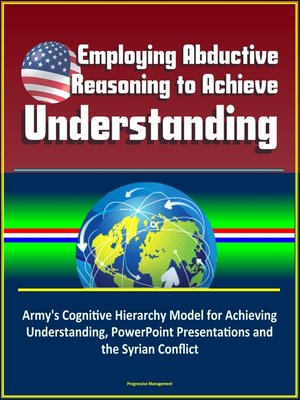Employing Abductive Reasoning to Achieve Understanding
ebook ∣ Army's Cognitive Hierarchy Model for Achieving Understanding, PowerPoint Presentations and the Syrian Conflict
By Progressive Management

Sign up to save your library
With an OverDrive account, you can save your favorite libraries for at-a-glance information about availability. Find out more about OverDrive accounts.
Find this title in Libby, the library reading app by OverDrive.



Search for a digital library with this title
Title found at these libraries:
| Loading... |
This excellent report has been professionally converted for accurate flowing-text e-book format reproduction. The future operational environment is described as volatile, uncertain, complex, and ambiguous and composed of numerous dynamic and adaptive systems whose interactions produce unanticipated and disproportionate outcomes. To fulfill the Army's roles of preventing conflict, shaping the international environment, and winning the nation's wars in this future environment, military professionals must cultivate an ability to achieve understanding. According to the Army's cognitive hierarchy model for achieving understanding, military professionals must: (1) process data to form information; (2) analyze information to create knowledge; and (3) synthesize knowledge and apply judgment to develop an understanding. Yet, according to top military leaders, Army professionals are not doing this, which has contributed to poor strategic outcomes. To address this gap, Army mid-career Professional Military Education needs to cultivate among students the habit of abductive reasoning, which requires the integration of mature theories into military work. To test the utility of abductive reasoning, the Army's cognitive hierarchy model for achieving understanding is applied to five Command and General Staff Officers' Course student groups' PowerPoint presentations of the Syrian conflict: four completed by groups which do not explicitly employ abductive reasoning and one which does. While not conclusive, the results of this study suggest that the group employing abductive reasoning achieved an understanding of the complexities of the Syrian conflict while the other four groups did not.
CHAPTER 1 - INTRODUCTION * Purpose and Proposed Approach to Improving Understanding * Findings and Implications * Overview * CHAPTER 2 - LITERATURE REVIEW * The Human Domain * The Nature of an Operational Environment * The Army's Cognitive Hierarchy Model for Achieving Understanding * Achieving an Understanding of an Operational Environment * Abductive Reasoning * Abductive Reasoning and the Military Professional * Conclusion * CHAPTER 3 - METHODOLOGY * PowerPoint Presentations and the Military * CGSOC Student Groups Used in this Study * Examples of the Army's Cognitive Hierarchy Model * Analyzing the Content of PowerPoint Presentations * Limitations * Conclusion * CHAPTER 4 - ANALYSIS * CGSOC Student Groups' Presentations on the Syrian Conflict * Discussion of Assessment * Conclusion * CHAPTER 5 - CONCLUSIONS AND RECOMMENDATIONS * Recommendations * BIBLIOGRAPHY
Abductive reasoning is proffered as an approach which can help military professionals improve their understanding of the operational environment. Ian Shapiro, Sterling Professor of Political Science and Henry R. Luce Director for The Whitney and Betty MacMillian Center for International and Area Studies at Yale University, defines abductive reasoning as "reasoning on the basis of mature theories from observed effects to unobservable causes . . . as a way of generating knowledge in which theory plays a vital role." Although not explicitly named in doctrine, abductive reasoning is not a completely new approach to developing an understanding of an operational environment.






